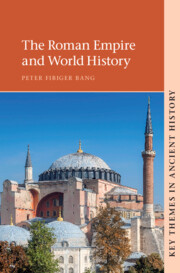Refine search
Actions for selected content:
23971 results in Ancient history
Contents
-
- Book:
- Cyril of Alexandria: <i>Against Julian</i>
- Published online:
- 26 September 2025
- Print publication:
- 16 October 2025, pp vii-viii
-
- Chapter
- Export citation
Book 10
- from Against Julian
-
- Book:
- Cyril of Alexandria: <i>Against Julian</i>
- Published online:
- 26 September 2025
- Print publication:
- 16 October 2025, pp 490-536
-
- Chapter
- Export citation
Copyright page
-
- Book:
- Cyril of Alexandria: <i>Against Julian</i>
- Published online:
- 26 September 2025
- Print publication:
- 16 October 2025, pp iv-iv
-
- Chapter
- Export citation
Chapter 8 - Ciceronian Aspects of Leadership in Livy’s Ab Vrbe Condita
-
-
- Book:
- Leadership in the Ancient World
- Published online:
- 14 September 2025
- Print publication:
- 16 October 2025, pp 176-200
-
- Chapter
- Export citation
Indexes
-
- Book:
- Cyril of Alexandria: <i>Against Julian</i>
- Published online:
- 26 September 2025
- Print publication:
- 16 October 2025, pp 614-614
-
- Chapter
- Export citation
Acknowledgements
-
- Book:
- Leadership in the Ancient World
- Published online:
- 14 September 2025
- Print publication:
- 16 October 2025, pp xiv-xvi
-
- Chapter
- Export citation
Chapter 9 - Imperial and Episcopal Leadership Networks in the Later Roman Empire
-
-
- Book:
- Leadership in the Ancient World
- Published online:
- 14 September 2025
- Print publication:
- 16 October 2025, pp 201-222
-
- Chapter
- Export citation
1 - Palmyra in the Mediterranean World
-
-
- Book:
- Palmyra, the Mediterranean and Beyond
- Published online:
- 21 October 2025
- Print publication:
- 16 October 2025, pp 1-20
-
- Chapter
- Export citation
8 - Channels of Communication and Connections of Style
-
-
- Book:
- Palmyra, the Mediterranean and Beyond
- Published online:
- 21 October 2025
- Print publication:
- 16 October 2025, pp 167-186
-
- Chapter
- Export citation
Other Ancient Sources Index
- from Indexes
-
- Book:
- Cyril of Alexandria: <i>Against Julian</i>
- Published online:
- 26 September 2025
- Print publication:
- 16 October 2025, pp 623-645
-
- Chapter
- Export citation
Introduction
-
-
- Book:
- Leadership in the Ancient World
- Published online:
- 14 September 2025
- Print publication:
- 16 October 2025, pp 1-13
-
- Chapter
- Export citation

The Roman Empire and World History
- Coming soon
-
- Expected online publication date:
- October 2025
- Print publication:
- 30 October 2025
-
- Book
- Export citation
Biblical Index
- from Indexes
-
- Book:
- Cyril of Alexandria: <i>Against Julian</i>
- Published online:
- 26 September 2025
- Print publication:
- 16 October 2025, pp 614-623
-
- Chapter
- Export citation
Chapter 6 - Divine Kingship as Reflected in Deuterocanonical Literature
-
-
- Book:
- Leadership in the Ancient World
- Published online:
- 14 September 2025
- Print publication:
- 16 October 2025, pp 133-152
-
- Chapter
- Export citation
Copyright page
-
- Book:
- Palmyra, the Mediterranean and Beyond
- Published online:
- 21 October 2025
- Print publication:
- 16 October 2025, pp iv-iv
-
- Chapter
- Export citation
Contributors
-
- Book:
- Palmyra, the Mediterranean and Beyond
- Published online:
- 21 October 2025
- Print publication:
- 16 October 2025, pp xi-xiv
-
- Chapter
- Export citation
Figures
-
- Book:
- Leadership in the Ancient World
- Published online:
- 14 September 2025
- Print publication:
- 16 October 2025, pp ix-ix
-
- Chapter
- Export citation
Book 7
- from Against Julian
-
- Book:
- Cyril of Alexandria: <i>Against Julian</i>
- Published online:
- 26 September 2025
- Print publication:
- 16 October 2025, pp 347-387
-
- Chapter
- Export citation
Dedication
-
- Book:
- Cyril of Alexandria: <i>Against Julian</i>
- Published online:
- 26 September 2025
- Print publication:
- 16 October 2025, pp v-vi
-
- Chapter
- Export citation
Figures
-
- Book:
- Palmyra, the Mediterranean and Beyond
- Published online:
- 21 October 2025
- Print publication:
- 16 October 2025, pp vii-ix
-
- Chapter
- Export citation
